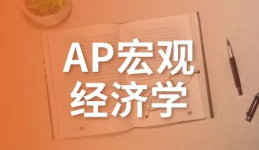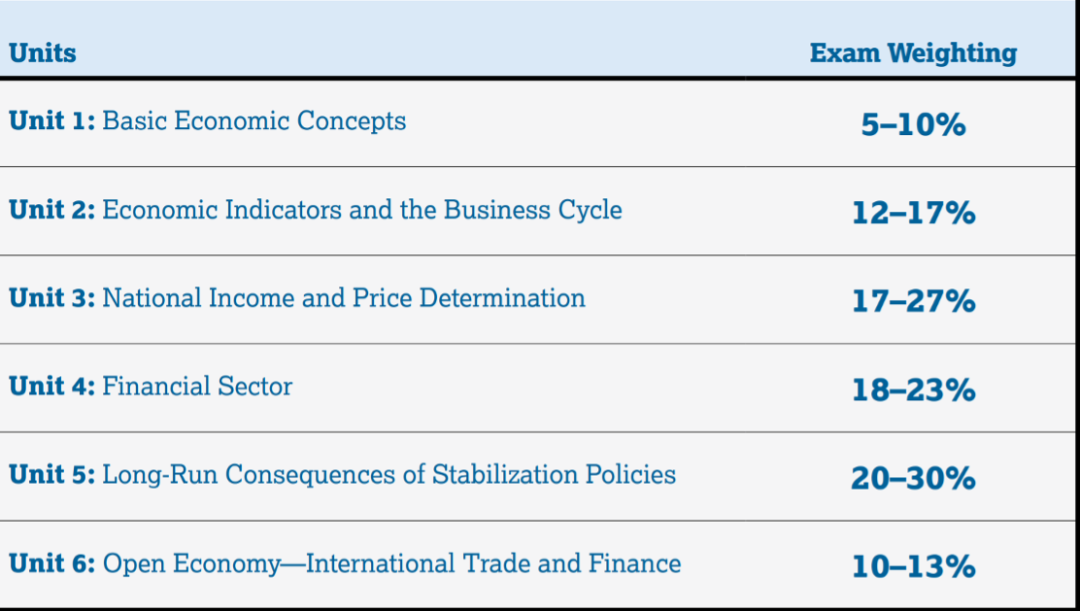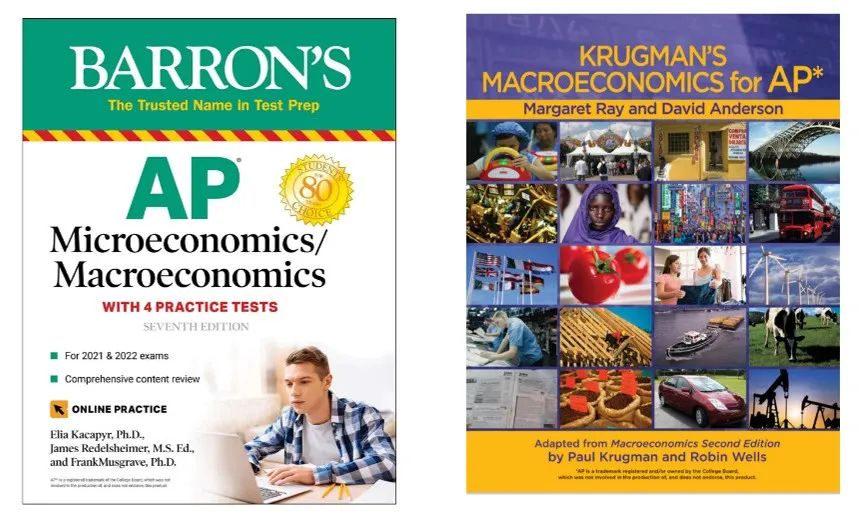- 翰林提供学术活动、国际课程、科研项目一站式留学背景提升服务!
- 400 888 0080
AP宏观经济学课程知识点全面梳理!
在众多AP科目中,选择AP经济学的学生人数占比较多,基本属于准备申请商科的学生基本必考的科目。并且,AP经济学并不是很难,虽然分为了AP微观经济学和AP宏观经济学,不过这两个科目侧重点并不同。微观经济学更贴近生活比较容易理解,而宏观经济学则离我们的日常生活有一定距离。
今天这篇文章是AP宏观经济学的科目解析。
学科简介
 AP宏观经济主要涉及大一经济学的基础内容,考试主要考察学生对经济学现象的认知能力,经济问题解决办法了解和相关经济学指标的计算能力。整体深度不高,适合所有理工科和商科学生学习。
AP宏观经济主要涉及大一经济学的基础内容,考试主要考察学生对经济学现象的认知能力,经济问题解决办法了解和相关经济学指标的计算能力。整体深度不高,适合所有理工科和商科学生学习。
相较于心理学,历史,英语语言文学等,AP宏观经济学并不需要特别高的英语水平,一般托福70分(阅读能力18+)就可以读懂题目。所以对于英语能力没有那么好的同学会是一个很好的选择。
课程内容
AP宏观经济学总共包含6个单元的内容。其中第一单元和微观经济重合,后5个单元全部是宏观的内容。
 AP宏观经济的考点分数分布
AP宏观经济的考点分数分布
I.Basic economic concepts (8–12%)
1.Scarcity, choice and opportunity costs 稀缺性、选择和机会成本
2.Production possibilities curve 生产可能性曲线
3.Comparative advantage, absolute advantage,specialization and exchange 比较优势,分工,交换
4.Demand, supply and market equilibrium 需求,供给,市场均衡
5.Macroeconomic issues: business cycle,unemployment, inflation, growth 经济周期,失业,通货膨胀,增长
II.Measurement of Economic Performance (12–16%)
A.National income accounts 国民收入账户
1.Circular flow 循环
2.Gross domestic product 国民生产总值(GDP)
3.Components of gross domestic product 国民生产总值的构成
4.Real versus nominal gross domestic product 实际与名义GDP
B.Inflation measurement and adjustment 通货膨胀
1.Price indices 价格指数
2.Nominal and real values 名义价格与实际价格
3.Costs of inflation 通货膨胀的(社会)成本
C.Unemployment 失业
1.Definition and measurement 定义和度量指标
2.Types of unemployment 失业的类型
3.Natural rate of unemployment 自然失业率
III. National Income and Price Determination (10–15%)
A.Aggregate demand 总需求
1.Determinants of aggregate demand 总需求的决定
2.Multiplier and crowding-out effects 乘数效应与挤出效应
B.Aggregate supply 总供给
1.Short-run and long-run analyses 短期与长期分析
2.Sticky versus flexible wages and prices 工资与价格的黏性与自由伸缩性
3.Determinants of aggregate supply 总供给的决定
C.Macroeconomic equilibrium 宏观经济均衡
1.Real output and price level 实际产出与价格水平
2.Short and long run 短期与长期
3.Actual versus full-employment output 实际产出与充分就业产出
4.Economic fluctuations 经济波动
IV.Financial Sector (15–20%)
A.Money, banking and financial markets 货币、银行与资本市场
1.Definition of financial assets: money, stocks, bonds 货币、股票与债券的定义
2.Time value of money (present and future value) 货币的时间价值
3.Measures of money supply 货币供给的度量
4.Banks and creation of money 银行与货币的创造
5.Money demand 货币需求
6.Money market 资本市场
7.Loanable funds market 可贷资金市场
B.Central bank and control of the money supply 中央银行和控制货币供给
1.Tools of central bank policy 政策工具
2.Quantity theory of money 货币数量论
3.Real versus nominal interest rates 实际与名义利率
V.Inflation, Unemployment, and Stabilization Policies (20–30%) 通货膨胀、失业与稳定政策
A.Fiscal and monetary policies 财政政策与货币政策
1.Demand-side effects 需求方
2.Supply-side effects 供给方
3.Policy mix 混合政策
4.Government deficits and debt 财政赤字与政府债务
B.Inflation and unemployment 通货膨胀与失业
1.Types of inflation 通货膨胀的类型(成因)
2.Demand-pull inflation 需求拉动型
3.Cost-push inflation 成本推动型
4.Role of expectations 期望(预期)的影响
VI. Economic Growth and Productivity (5–10%) 经济增长与生产率
1.Investment in human capital 人力资本投资
2.Investment in physical capital 物质资本投资
3.Research and development, and technological progress 研发与技术进步
4.Growth policy 增长政策
VII. Open Economy:International Trade and Finance (10–15%) 开放经济,国际贸易与国际金融(资本)
A.Balance of payments accounts 国际贸易收支账户
1.Balance of trade 贸易平衡
2.Current account 经常账户
3.Capital account 资本账户
B.Foreign exchange market 外汇市场
1.Demand for and supply of foreign exchange 外汇的供求
2.Exchange rate determination 汇率
3.Currency appreciation and depreciation 货币升值与贬值
C.Net exports and capital flows 净出口与资本流动
D.Links to financial and goods markets 资本市场与产品市场的关系
如何学习经济学
1、Active Reading/Learning 主动式阅读/学习
2、Going Back and Forward 反复查看学过的内容
3、Understanding Instead of Memorizing 理解知识点
学习资料推荐
1、巴朗AP宏微观经济学
前面是微观,后面是宏观,知识及配图都比较容易理解,内容相对精炼。
2、Krugman的AP宏观经济学
知识点讲解非常细致,练习题也较多,难度稍高。适合时间充裕,详细探究的同学。
3、历年真题

需要针对AP考试辅导提升的同学,欢迎扫码咨询~
还能【免费领取】相关真题及解析,1V1制定课程!

最新发布
© 2025. All Rights Reserved. 沪ICP备2023009024号-1









